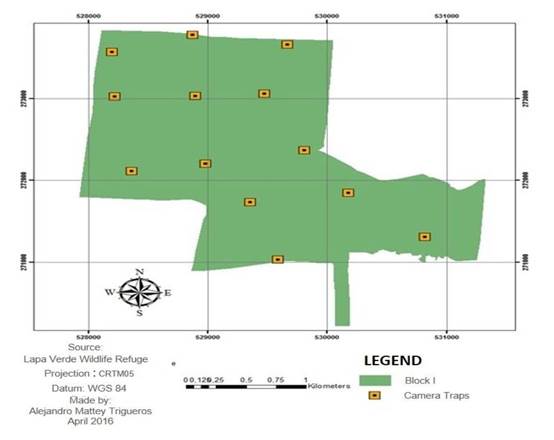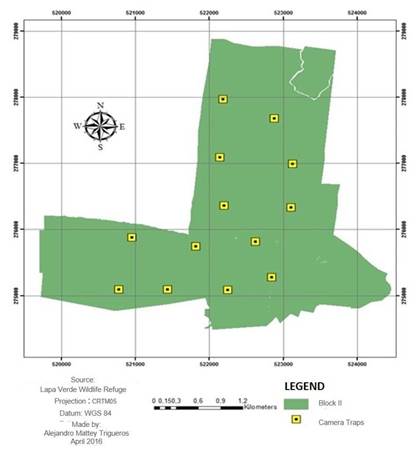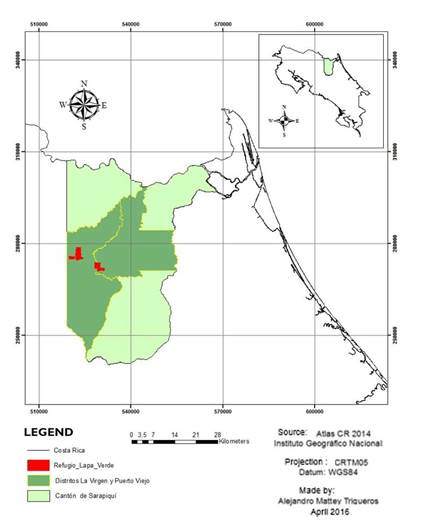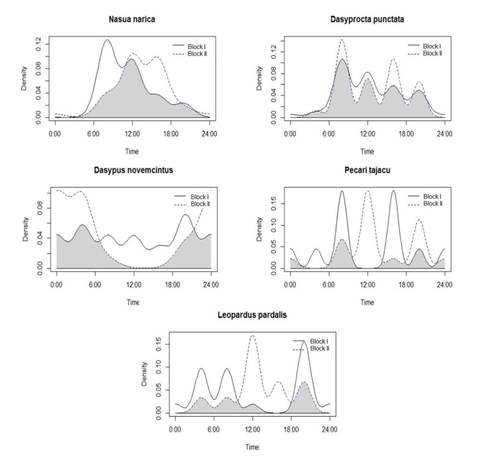1. Introduction
Worldwide, there are approximately 6,495 described species of mammals (Burgin et al., 2018 ), of which 253 are described for Costa Rica. They include 115 species of bats, 31 marine and 222 species of terrestrial mammals (Carrillo et al., 2002; Rodríguez-Herrera et al., 2014; Villalobos et al., 2018; Wainwrigth, 2007). Their importance lies in the interaction at the level of ecosystem processes, including pollination, seed dispersion, and predator and prey relationships, which directly influence the structure and composition of vegetation and mediate in the nutrient cycle (Boddicker et al., 2002).
In Costa Rica, there is a necessity for generating information about mammals because some areas of the country lack information about their diversity and conservation status. Specific research in the biological corridors’ areas is scarce but essential to promote effective management actions that result in the reduction of the threats that mammals suffer (Sáenz, 2010). These types of investigations are important to study the influence of connectivity in the study on mammals to validate conservation and management strategies with scientific data. Despite the extensive use of camera traps, it is one of the least used methods to study the effects of connectivity on biodiversity in Latin America (Leija & Mendoza, 2021).
Areas that provide this connectivity for species with ecological importance, such as medium and large mammals, are of importance since these species are highly affected by processes of deforestation, hunting, and isolation that are experienced in the region. They generate pressure on the populations of these species and condition their future survival (Meyer et al. 2019). In addition, these areas represent an important conservation strategy trying to reduce pressure on protected areas and being used as environmental education tools while combining the protection of wildlife with economic activities such as crops or livestock (Zumbado-Morales & Aguero-Valverde, 2020).
For example, Costa Rica shows important conflicts regarding deforestation due to the extension of the agricultural frontier, as well as other conservation threats like illegal logging, which respond to economic, social, cultural, political, and legal causes. This has affected primarily the harvest of all species in primary forests resulting in an impact on landscapes (Programa Estado de la Nación, 2020). In spite of the accelerated rate of deforestation and the high fragmentation of forests that have occurred to date, ambitious projects, like biological corridors, represent an opportunity to mitigate the effects of climate change (Canet-Desanti et al., 2012). One of these important projects is the Mesoamerican Biological Corridor (MBC), launched in 1999. It is a strategy aiming to create a regional corridor that extends from southern Mexico to Panama. This allows the connection between protected areas and remnants of Central American forest (SINAC-MINAE, 2008). Part of this corridor, Lapa Verde Wildlife Refuge (LVWR), is considered a key area for the connection of the MBC since this area has a high value for its biodiversity, so it is an indispensable territory for connectivity between the Caribbean northern zone and the conservation areas in the center of Costa Rica. This allows the country to work as a bridge between North and South America. Thus, it is essential to generate information about the population status of the species that inhabit it (Chassot & Monge, 2002).
This research effort represents the first initiative that Lapa Verde Wildlife Refuge carried out to evaluate the medium and large mammal’s diversity in its forests. The aim of this study is to generate baseline information on the diversity of medium and large terrestrial mammals and their activity patterns in the Lapa Verde Wildlife Refuge, Sarapiquí, Heredia, Costa Rica. The data generated will inform science-driven decision-making and management of mammals.
2. Methodology
2.1 Study area
The Lapa Verde Wildlife Refuge (LVWR) is in the northeast of Costa Rica, Sarapiquí, Heredia Province (Figure 1). It extends over an area of approximately 1 800 ha, of which approximately 1400 are covered with forest. The refuge is divided into two blocks. Block I (B I) with 685 ha, which is in the community of Chilamate at 6 km from the Puerto Viejo town (Figure 2). Block II (B II), with 1 170 ha, is in La Virgen of Sarapiquí, in the communities of California Tico, Río Magdalena, and Pueblo Nuevo (Figure 3).

Figure 2 Location of the camera traps in the sampling block I. Lapa Verde Wildlife Refuge, Heredia, Costa Rica.

Figure 3 Location of camera traps in block II of sampling. Lapa Verde Wildlife Refuge, Heredia, Costa Rica.
According to the Holdridge’s life zones classification, the predominant life zone in the area is Very Humid Tropical Forest (bmh-T). It is characterized by high precipitation with averages ranging from 3 000 to 5 400 mm, and with an average temperature of 26.1 °C, ranging from 20.7 °C to 32.5 °C (Holdridge & Tosi, 1967).
The main productive activities that take place in the surroundings of the LVWR are livestock and expansive pineapple plantations. Other activities present in lower intensity are crops of basic grains, tubers, heart of palm plantations, and some monoculture plantations of exotic timber species such as Melina (Gmelina arborea) and Teak (Tectona grandis) (Chassot & Monge, 2002).
2.2 Experimental design
In this study, we used the camera-trapping methodology (Karanth & Nichols, 1998). According to Monroy et al. (2010), it is one of the most effective techniques for estimating the abundance of wild species and achieving an evaluation of the population’s status for their conservation. This study was carried out in two phases to cover the two conservation blocks managed by the Lapa Verde Wildlife Refuge. The first phase of data collection was carried out during the months of January and February 2015 in the Sampling Block I (Chilamate); the second phase was developed during the months of December 2015 and January 2016 in Block II (Pueblo Nuevo).
In each sampling block (Figure 2 and Figure 3) 13 camera traps were installed (Bushnell Trophy Camera, Model 119537 and Moultrie, model MCG-12596). The equipment was attached to trees and secured with safety chains at 50 cm from the ground, in order to avoid camera extraction and loss of data due to equipment theft. Each device was installed at an average distance of 750 m of each other and placed on passages where animal tracks and signs were present (Díaz-Pulido & Payán-Garrido, 2012). The surroundings of each camera were clear areas without dense understory to allow the capture of better images.
The cameras were programmed to remain active for 24 h (necessary to calculate night sampling) and olfactory attractants were used in each one, consisting of stakes with pieces of cotton cloth dipped completely with Obsession perfume of the Kalvin Klein brand (Monroy et al., 2010; Gonthier & Castañeda, 2013; Díaz-Pulido & Payán-Garrido, 2012). The cameras were checked every 15 days to verify their proper functioning, change batteries and memory cards if necessary.
Data Analysis. The identification of the species photographed was done using field guides (Wainwrigth, 2007, Reid 2009). Data were analyzed using EstimateS statistical software, (Díaz & Payan, 2012) and the statistical program R version 3.5.1. Relative Abundance Index (RAI) was carried out for independent photographs, using Equation 1. To estimate abundance more accurately, we used the technique by Monroy et al. (2010).
RAI= events*100 camera trap nights/sampling effort (E.1) Where: RAI: relative abundance index for species 'a’ Events: number of independent records per species 100 camera trap nights: unit of standardization to compare data with other studies Sampling effort: total amount of nights that the camera trap stations were working
To determine the patterns of circadian activity, a record of the occurrence of the species was made, analyzing the frequency (Number of photos in every interval of time) of activity of each to calculate the time of day they were more active. Only the species with a minimum of 11 independent photographic records and had the time set in the photograph were taken into account. This number of records has been considered as the minimum necessary to describe the pattern of circadian activity of a species (Maffei et al., 2002). The data obtained were ordered in four-hour intervals to define and perform the analysis of the circadian activity pattern by species in these ranges and contrast between the results obtained between both blocks.
3. Results
3.1 Species richness
A sampling effort of 795 camera nights (nights installed on the field per amount of cameras) for Block I and 789 in Block II was made for a total of 1,584 camera nights. A total of 18 species distributed in 12 families were captured, of which 15 species are shared between both sampling blocks (Table 1). Only 6 species, Canis latrans, Panthera onca, Galictis vittata, Silvilagus gabbi, Procyon lotor, and Tapirus bairdii were not shared, corresponding to 33.3 % of the recorded species. Among the families that were registered, Felidae is the most representative with 4 species: Panthera onca, Leopardus pardalis, Leopardus wiedii and Puma yagouaroundi. In addition, 6 trophic guilds were found, and the presence in the study area of large and medium predators such as P. onca, C. latrans, L. pardalis, and L. wiedii should be highlighted.
In addition, there are herbivorous and frugivorous species in the area, for example, Silvilagus sp., Tapirus bairdii, Dasypus novemcinctus, Dasyprocta punctata and Cuniculus paca (Table 1). On the other hand, the conservation status of the captured species is important to take in consideration. For example, P. onca and L. wiedii that are near threatened and M. temama which does not have enough data to generate an accurate conservation status (Table 1).
Table 1 Medium and large mammal species recorded in both sampling blocks (I and II), with their respective trophic guild and conservation status according to IUCN. Lapa Verde Wildlife Refuge, Heredia, Costa Rica.
| Family | Specie | Trophic Guild | Local name | UICN |
|---|---|---|---|---|
| Canidae | Canis latrans | C | Coyote | LC |
| Cuniculidae | Cuniculus paca | G, F | Tepezcuintle | LC |
| Dasyproctidae | Dasyprocta punctata | G, F | Guatusa | LC |
| Dasypodidae | Dasypus novemcinctus | I | Armadillo | LC |
| Mustelidae | Eira barbara | O | Tolomuco | LC |
| Galictis vittata | O | Grisón | LC | |
| Felidae | Leopardus pardalis | C | Manigordo | LC |
| Leopardus wiedii | C | Caucel | NT | |
| Puma yagouaroundi | C | Jaguaroundi | LC | |
| Panthera onca | C | Jaguar | NT | |
| Procyonidae | Nasua narica | O | Pizote | LC |
| Procyon lotor | O | Mapache | LC | |
| Cervidae | Odocoileus virginianus | H | Venado cola blanca | LC |
| Mazama temama | H | Cabro de monte | DD | |
| Tayassuidae | Pecari tajacu | H | Saíno | LC |
| Leporidae | Silvilagus gabbi | H | Conejo de monte | NA |
| Myrmecophagidae | Tamandua mexicana | I | Oso hormiguero | LC |
| Tapiridae | Tapirus bardii | H | Danta | LC |
C = carnivorous, G = granivorous, F = frugivorous, I = insectivorous, O = omnivorous, H = herbivore. In addition, its conservation status according to IUCN with acronym in English, LC = Least concern, NT = Near threatened, DD = deficient data and NA = not applicable since no identification was made at the species level.
3.2 Relative Abundance Index
The species with the highest RAI for both blocks was D. punctata (Block I: 80.50 and Block II: 63.37) and showed similar values and number of catches at the two sampling sites. N. narica showed the second highest value of RAI in Block II (63.37); however, in Block I it was only registered on one occasion obtaining a very low RAI (1.25). Some species, such as D. novemcinctus (Block I, RAI = 22.64, Block II, RAI = 30.42) and L. pardalis (Block I, RAI = 16. 35, Block II, RAI = 12.67), obtained similar records and therefore a very similar RAI for both sampling blocks.
There were species that showed a single record, such as P. onca, which registered only in Block I and G. vittata that failed to be registered in Block I and was recorded in a single occasion in Block II. In the case of T. bardii, it showed only two records in Block II, while P. yagouarondi. L. wiedii who obtained a few records in one of the blocks and other only one record in the other block. It differs from this pattern C. latrans that despite presenting 13 records in Block I (RAI = 16.35) it was not registered for block II. For the other species, differences of records were found between the two sampling blocks, such as P. tajacu, O. virginianus, C. paca, T. mexicana, M. mazama and E. barbara (Table 2).
Table 2 Number of records and Relative abundance (RAI) of medium and large mammals' species recorded by sampling block in the study area.
| Species | Records Block I | RAI Block I | Records Block II | RAI Block II |
|---|---|---|---|---|
| Canis latrans | 13 | 16.35 | 0 | 0.00 |
| Cuniculus paca | 5 | 3.77 | 7 | 8.87 |
| Dasyprocta punctata | 90 | 80.50 | 50 | 63.37 |
| Dasypus novemcinctus | 20 | 22.64 | 24 | 30.42 |
| Eira barbara | 15 | 16.35 | 5 | 6.34 |
| Galictis vittata | 0 | 0.00 | 1 | 1.27 |
| Leopardus pardalis | 19 | 16.35 | 10 | 12.67 |
| Leopardus wiedii | 1 | 1.25 | 4 | 5.07 |
| Puma yagouaroundi | 4 | 5.03 | 1 | 1.27 |
| Panthera onca | 1 | 1.03 | 0 | 0.00 |
| Nasua Narica | 10 | 1.25 | 50 | 63.37 |
| Procyon lotor | 2 | 2.51 | 0 | 0.00 |
| Odocoileus virginianus | 2 | 2.51 | 14 | 17.74 |
| Mazama americana | 0 | 0.00 | 5 | 6.34 |
| Pecari tajacu | 8 | 10.06 | 19 | 24.08 |
| Silvilagus gabbi | 4 | 5.03 | 0 | 0.00 |
| Tamandua mexicana | 4 | 5.03 | 7 | 8.87 |
| Tapirus bairdii | 0 | 0.00 | 2 | 2.54 |
3.3 Circadian activity patterns
The comparison between patterns of circadian activity presented in Figure 4 and Figure 5 shows patterns among the species that were shared between the study blocks. Since 3 species presented different patterns in terms of their peak activity, like L. pardalis, with the highest nocturnal activity in Block I, while Block II, the highest number of records were obtained in the morning and mid-day. D. novemcinctus, meanwhile, was recorded throughout the day in the Block I while in Block II catches were focused on night hours, showing a difference of activity of the same species between the two blocks. Other species showing more activity during the day were P. tajacu, N. narica, and D. punctate,
In the case of L. pardalis, the exception should be made that its activity pattern was included in the analysis despite having 10 catches (less than recommended to perform an activity pattern as mentioned in the Methods section). This was made in order to obtain data and patterns that allow identifying specific conditions of the sampling site to propose management and protection actions for this species. The exception was made considering that the species is a common predator in the study area.
4. Discussion
The number of species recorded in this study was similar compared to studies carried out in the region, in which the majority of medium and large mammal species are shared. For example, Salom et al. (2015) with a sampling effort of 3 640 nights (higher than this study) recorded 22 species, compared to the 18 captured in our sampling area. In another study, Arroyo-Arce et al. (2017), also in the Caribbean lowlands of Costa Rica, had a sampling effort quite similar (1 643 nights) to the present study and found 11 species with carnivores as the most common group, including three species of felines. Something important to highlight is the fact that L. pardalis was the feline species with the highest number of catches, this coincides with different studies in different areas of the country (Bustamante, 2008; Corrales-Gutiérrez et al. 2012; Salom et al., 2015; Sáenz, 2010) and is probably in response to the ability of this species to colonize both disturbed and dense forests sites (Cruz-Rodríguez, 2012; Pérez-Irineo & Santos-Moreno, 2014).
The Wildlife Refuge allows the establishment of populations of umbrella species with different habitat selection criteria, such as P. onca, which is a species more related to dense forests and sites slightly altered in contrast to N. narica associated with more open areas, with lower forest cover density (Foster & Vaughan, 2002; Pacheco et al., 2006). In addition, it should be noted that of the 18 species found throughout the study, 5 have a carnivorous trophic guild, which indirectly indicates the quality and condition of the study area because the presence of predators and top predators such as Jaguars are good indicators of prey populations in the trophic chain due to predator-prey interactions. (Crooks et al., 2011; Mora, 2017). Besides, there are species that serve as prey for large and medium predators and perform important ecological functions such as seed dispersal. This allows maintaining the life cycle of many plants and their roles in the ecosystem, for example, Silvilagus sp., Tapirus bairdii, Dasypus novemcinctus, Dasyprocta punctata, and Cuniculus paca(Mittelman et al., 2020; Wainwrigth, 2007).
The activity patterns recorded in this study show that data regarding the behavior of the same species varies between sampling blocks. These differences can be attributed to three main causes related to the degree of anthropogenic disturbance present in the study site.
In Block II there is a constant movement of machinery to attend the pineapple production farm. Considering the block is immersed in a matrix of pineapple monoculture plantations, this could generate effects on the activity of the species due to noise pollution and vulnerability to roadkill. This may represent a marked difference with respect to Block I in which there is no access to machinery and can only be accessed through trails.
Of the different stages of ecological succession between the sampling sites, Block II has large fragments of natural regeneration in early succession stages and is currently used by timber plantations. Block I did not present a disturbance in terms of timber exploitation and is mainly covered by forest in more advanced succession stages than Block II (Rojas-Durán, 2010). This could influence the difference in the patterns of circadian activity between sampling blocks (Acevedo‐Charry & Aide, 2019; Paviolo et al. 2009).
Poaching can be one of the differences between the degree of conservation of both sampling blocks. As a personal observation, it is noted that complaints of hunting in Block II were more frequent than in Block I. The presence of poaching is crucial to understand data of wealth and circadian activity patterns as highlighted by Di Bitteli et al. (2008) because this activity can affect the hunting of target species and their predators, affecting, in turn, the ecosystem dynamics of the studied area.
These differences between sampling sites could allude to the differences between the blocks’ samplings explained previously, but further research should be conducted for better understanding of the causes of the differences found in this study. The behavior of the species studied will vary according to environmental pressures, both for predatory species and for predated species (Monterroso et al., 2013), which increases the importance of studies that generate the first approach to identify the pressures and possible management actions that can be used in a given area.
5. Conclusions
The evidence showing that species such jaguars and tapirs, which require large areas of land to settle, use these conservation blocks indicates the importance of the conservation of these blocks, the expanse of conservation lands, and the improvement of their connectivity to provide habitat for these important species.
The information of this study has importance as a baseline for future studies that we consider to be focus on long-term projects and expand the studies to private and national protected areas in the region to have a clear result about the connectivity in this study area. The other important aspect to highlight is that this study was carried out in a period of 4 months which corresponds to the dry season in Costa Rica, so this research represents a baseline on the diversity of mammals in the refuge and some aspects of their activity. Therefore, it is necessary to expand with other studies that consider both climatic seasons in Costa Rica.
An important component to take into account for future studies is the application of occupancy modeling to explain, in a better way, the use of the landscape of medium and large terrestrial mammals.
6. Ethics and conflict of interest
The authors declare that they have fully complied with all pertinent ethical and legal requirements, both during the study and in the production of the manuscript; that there are no conflicts of interest of any kind; that all financial sources are fully and clearly mentioned in the acknowledgments section; and that they fully agree with the final edited version of the article.












 uBio
uBio 





